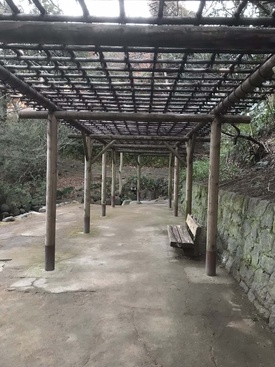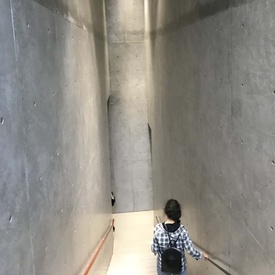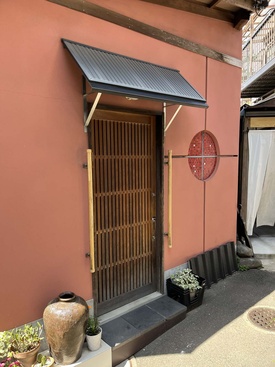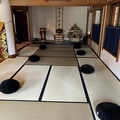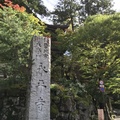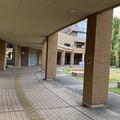Yayoi and I walked across a university campus admiring its historic gate, patinaed statues, and path replete with fallen yellow fan-shaped leaves. We had passed through here before on our way to her house, but this time she invited me to take the lead, testing whether I had paid attention and remembered the many shortcuts she took that made an already difficult route even harder. I failed.
Once we exited campus, Yayoi was forced to lead the way as I followed dutifully, slowing my gait—which she often chided as being too fast. I was relieved from having to navigate on my own through an unfamiliar and tricky part of the city.
I first met Yayoi at a meditation retreat soon after I arrived in Tokyo. During a break from zazen, we practitioners decided to pay respects to the towering Kannon statue in the temple cemetery. As we gathered, a mature woman wearing a faded blue cotton outfit with kimono-styled top and loose bottoms approached me. She grabbed my hand firmly—something no gray-haired Japanese grannie would do—then tilted her head girlishly with a coy smile.
This was Yayoi. When a well-meaning practitioner blurted out that she was actually Korean, Yayoi barked at him. “Why do you always call me a gaijin when I’ve lived here for almost as long as you, old man?”
Yayoi wasn’t like the hundreds of thousands of Koreans who had been conscripted to labor in Japan after their country was conquered by the Japanese empire. She came long after World War Two ended, and thus didn’t share in the suffering and humiliation that generations of Zainichi Koreans faced as stigmatized minorities in Japan. On the contrary, Yayoi and her Taiwanese husband prized living in Tokyo, and their families back home in now independent Korea and Taiwan envied their modern Japanese lifestyle.
But Yayoi was not blind to the anti-Korean racism that persisted in her adopted homeland. For whatever reason, the hatred against residents of Korean descent was much more severe than that against those from Japan’s other former colony of Taiwan.
Yayoi confronted this unfortunate distinction when on a trip abroad run by a Japanese tour company. Because she travelled alone, she was assigned a roommate from Osaka—one who quickly became a delightful travel companion. Yet, as it turned out, the pleasant roomie was also a vicious racist who vented about her obnoxious and smelly Korean neighbors. One evening when talking before going to bed, she asked Yayoi about her accent.
“You don’t sound like a Japanese,” she said. Where are you from?”
“Taiwan,” Yayoi replied. Fortunately, the roommate let the matter drop without suspecting her true identity.
This story reminded me about some of my own experiences in the US as an ethnic minority—since, like Yayoi, I was trained through force of circumstances to be skilled in the art of identity concealment and disguise. For example, when I met white people for the first time, I usually didn’t tell them that my research focused on Asian Americans, because I was afraid that they’d dismiss my studies as trivial naval gazing, or even “wokeness.” “I’m a historian of the United States,” I’d say, revealing my actual research specialty only after the inquirer proved to my satisfaction that they weren’t racist.
Yet if Yayoi and I were both ethnic outsiders, I looked up to her as someone who had also managed to overcome the challenges of adapting to Japan despite the animosity there against Koreans. Not only did she become fluent in the language, she took the rare step of naturalizing to citizenship. Her successful assimilation was apparent in the one-hundred-year-old house she had bought and lovingly restored.
The interior, an eclectic mix of traditional and modern Japanese design, featured a tatami room with shoji screens and a nook where we’d sit zazen in front of a large metallic Buddha with an impish smile. To separate the kitchen from the tatami room, Yayoi had hung colorful fabric from a wide and stiff kimono sash (obi) while twisting another one around an exposed beam above it. Sandwiched between the two obi was a carved wooden panel, the kind that a Japanese friend said reminded him of his grandmother’s house.
As luck would have it, Yayoi’s place felt as warm and welcoming as my own grandma’s house. It was where we binge-watched a drama series about Zainichi Koreans, one in which Yayoi could understand the Korean and Japanese spoken, while I had to read the English subtitles. In between episodes, I asked her incessant questions about how she adapted so skillfully to Japan, while Yayoi, knowing that I wanted to follow in her footsteps, drilled me in Japanese verb conjugations, mentored me in dating Japanese women, and even tried to set me up with a few she thought would help my cause.
One of her matchmaking attempts came during a two-day bus trip to the mountains of Nagano prefecture. When we checked-in for the tour, the guide mistook us for mother and son—in addition to our obvious age difference, we were, after all, sharing a hotel room together that the guide couldn’t have known was done out of convenience (it was the only one left when we booked). Yayoi corrected the guide’s mistake, saying loud enough for others to hear that we were just friends and that I was looking to meet available women.
Later when we were eating lunch, I tried to return the favor by pointing out an older gentleman on the tour and asking Yayoi what she thought about him. She was dismissive. “That old guy likes younger women,” she said. “I tried to get him to sit with us during lunch, but instead he ate with those two OLs (office ladies).”
“Maybe they’re his daughters?”
“Nah.”
“I can understand him being interested romantically in one or both of them,” I said. “But what do they see in a man who is their father’s age?”
Yayoi looked me up and down through her fashionably large sunglasses. “My husband was eighteen years older than me,” she said. “We couldn’t speak much when we first met since he was a Taiwanese educated in Japan and I didn’t speak either Chinese or Japanese.”
After dinner and a long soak in the hotel’s onsen hot springs, Yayoi and I sat on tatami mats at a low table, drinking Sapporo beer from small glasses. Thin cotton fabric of yukata robes clung to our still damp skin. Meanwhile, two pre-teen brothers, sporting wet hair and dressed in matching superhero pajamas, were running on the smooth padded surface like it was a slip-and-slide.
I told Yayoi that while in the onsen I had again seen the good-looking gentleman and wanted to approach him on her behalf but sensed that he didn’t want to be disturbed, especially by a gaijin with broken Japanese. “He’s in good shape,” I said. “I hope I look like him when I’m his age.”
Yayoi shook her head. “I spoke with those two OLs while soaking,” she said. “They are middle school friends from Yokohama who both have college-age kids.” Since neither spoke English, Yayoi crossed them off the list of potential dates for me. She and I toasted wryly to our continued search for love, even as out of the corner of my eye I watched the pajamaed brothers squeal and slide into home plate.
As Yayoi poured me another glass of beer, I opened up about my troubled marriage. As much as my newfound interest in dating could be justified liberation from years of marital estrangement, I still felt guilty about breaking up my once-loving family. “I’m a bad father,” I confessed. She looked at me with consoling eyes. It was okay, she said, to move out of my house and date other women as long as I obeyed one surprising caveat. “Whatever you do,” she said, “don’t get divorced.”
In our hotel room later that night, Yayoi was in her bed under the covers when I emerged from the bathroom after washing up. I turned off the lights, said goodnight and hopped into my bed. A minute later, a dim light switched on. Yayoi was sitting up and staring towards the bathroom door. “I was a bad wife,” she said.
Yayoi explained how she had disappointed her husband. After they got married in Korea, he sponsored her to come to Japan and then got her through college, tutoring her in Japanese and even taking notes for her in class. By the time Yayoi had earned a bachelor’s degree and established a rewarding career as a Korean language instructor, she no longer needed her husband’s tutelage. He had grown older, while she was still young and wanted to take advantage of everything Tokyo had to offer. By and by, she ended up moving away from home with her teenage son, while never broaching the idea of divorce to her husband. He didn’t either.
After a decade of living apart, Yayoi returned to him. By this time, he had retired and become an alcoholic. He was defeated—after all, his beautiful young Korean wife had flowered, become Japanese, developed a successful career, and abandoned him. Yet, much to her chagrin, Yayoi’s time apart from her husband wasn’t a bowl of cherries either. She had been deeply hurt by one married man whom she loved and who had said he loved her and vowed to leave his wife—but then didn’t.
In her time of grief, she joined a zazen group, living in a practice facility with the group’s master and other practitioners. The experience inspired her to move back in with her husband. Doing so, she reckoned, was a form of Buddhist practice. Perhaps. But it was also her penance for betraying the man who had saved her from the fate of domesticity in Korea, and the father of her now-adult son.
Yayoi’s penitential duties didn’t last long. One day while she was out exercising, her husband suffered a brain hemorrhage and died on the spot. Although his passing meant that she didn’t have to endure many years of caretaking, her unfulfilled penance remained in the form of a guilty conscience that plagued her.
After returning from our trip to Nagano, I started to help Yayoi edit English translations of lectures given by the deceased founder of our zazen group. During her salad days, she had brought the master to Korea to deliver lectures that she had arranged with various universities. Some of her happiest memories derived from this trip, as she confessed to being secretly in love with the master. Her devotion to him was already apparent in two previous publications of these same lectures—one in the original Japanese and the other a Korean version that she had translated herself.
Yayoi and I worked together on the English version at her house after our weekly zazen meetings. Once while walking home from the group session, I volunteered to lead the way, finally able to usher her deftly through the university campus that I had failed to navigate before. From there, I ventured into the streets with Yayoi in tow, cutting through a temple grounds and stopping to pay respects at a statue of a retired sumo wrestler whom she had admired.
After making a hairpin turn around a beloved ninety-year-old cedar tree, I took us along a row of more temples, our steps keeping time to the low buzzing of monks chanting. I then entered a labyrinth of narrow passageways crammed with low-lying houses abutting each other at awkward angles. Following a sharp turn, we came upon a familiar persimmon-colored wall with a wood-slatted front door. Yayoi smiled and slapped my shoulder. She was both astonished and proud that I had successfully bought us home.
*This chapter is dedicated to the memory of “Yayoi” (1944-2022)—beloved friend, mentor, and fellow traveler on life’s winding road.
© 2023 Lon Kurashige


